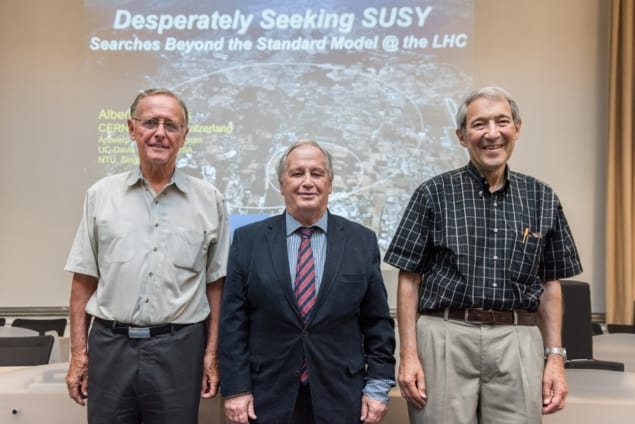
Three proponents of “supergravity” – a theory that attempts to unify all the forces of nature – have been awarded with a Special Breakthrough Prize worth $3m. Theorists Sergio Ferrara from the CERN particle-physics lab near Geneva, Daniel Freedman from the Massachusetts Institute of Technology and Stanford University, and Peter van Nieuwenhuizen from Stony Brook University, share the prize for work they carried out in the 1970s that unifies general relativity and supersymmetry. The announcement, however, has been met with derision by some who say that such a high-profile physics prize should not go to a speculative theory that has not been tested experimentally.
By the early 1970s, physicists had unified the electromagnetic, weak and strong forces via the now-famous Standard Model of particle physics, but gravity proved elusive. At the same time, quantum-field theorists found that the infinities that appeared in their calculations to unify gravity would often disappear if every particle happened to be accompanied by a partner with a spin that differed by half-multiples of h/2π, where h is Planck’s constant. They then postulated a universal “supersymmetry” between fermions and bosons, and vice-versa, but it was still a question whether this could be applied to gravity.
That is when Ferrara, Freedman and van Nieuwenhuizen took on the problem. The trio wrote down the theory of a spin-2 particle – the graviton – with a spin-3/2 field as its supersymmetric partner. When they ran their calculations through a computer they showed that they had indeed constructed a consistent field theory that combined general relativity with supersymmetry at every point of space–time.
The trio published their paper on 15 June 1976 (Phys. Rev. D 13 3214) and two months later van Nieuwenhuizen and Freedman published a follow-up paper for their new theory (Phys. Rev. D 14 912). The idea boomed and other theorists dived into supergravity. Supergravity is now thought of as a low-energy limit of string theory and it gave theoretical physics a boost along the road towards superstrings, which has become the prevailing effort to unify physics.
The community needs to admit failure and think about what went wrong, not put lipstick on a pig
Sabine Hossenfelder
The discovery of supergravity was the beginning of including quantum variables in describing the dynamics of spacetime,” notes Edward Witten from the Institute for Advanced Study at Princeton University, who chaired the 29-strong selection committee for the prize. “It is quite striking that Einstein’s equations admit the generalization that we know as supergravity.”
Supergravity is based on a symmetry principle – a symmetry between bosonic and fermionic fields. That symmetry can only be implemented if space–time is curved – that is, if gravity is present. Were supersymmetry to be found at, say, the Large Hadron Collider (LHC) at CERN, many models would imply supergravity as well. However, despite the LHC collecting a wealth of data over the last few years, there has been no sign of supersymmetry.
‘Failed ideas’
This absence of experimental proof for supergravity – and indeed supersymmetry – has led some to criticize the committee for giving the award for a theory that may never be grounded in reality. “I think this is a bad development,” Sabine Hossenfelder from the Frankfurt Institute for Advanced Study told Physics World. “The message here is clearly that in fundamental physics contact to observation is no longer necessary.” She says that the award gives the message that the foundations of physics is “not really science but in the best case a mixture of maths and philosophy [and] in the worst case just fantasy”. She also says that it tells researchers that they should “strive for popularity” to be considered successful. “With this [prize’s] high visibility comes a message and with that comes responsibility,” she adds.
Hossenfelder admits that supergravity has been influential and that it has given rise to mathematical insights, but she says that it should instead be called a prize for mathematics. “The problem is that we have no reason to think that just because a hypothesis is popular and inspiring it also has a good chance to be a correct description of nature,” she says, adding that supergravity is an example of “research bubbles of empty promise”. “The community needs to admit failure and think about what went wrong, not put lipstick on a pig,” she says.
The fact that one idea — supergravity — has had so many consequences shows its intellectual weight
David Tong
Those views are backed up by theoretical physicist Peter Woit from Columbia University, who has previously been critical of the Breakthrough prizes. “Exactly the possible damage I worried about due to this kind of prize has happened and is ongoing,” he told Physics World. “Due to its size, the prize has got a lot of attention, generating a lot of misleading positive publicity for failed theoretical ideas.”
Woit says that fundamental physics is “facing a difficult time” due to the failure of ideas that have dominated the subject for the past 40 years. “Awarding huge cash prizes for these failed ideas sends the wrong message and makes moving on more difficult,” he says. Woit adds that one problem with the current award is that the citation specifically argues for supersymmetry. “This completely ignores the strong LHC negative results about supersymmetry,” he says. “Giving a huge award for a theoretical idea that has just been falsified by experiment seems something no one should be doing.”
Recognizing ideas
In a Q&A on Stony Brook University’s website, van Nieuwenhuizen admits that the prize has been awarded for purely theoretical work. “The proof is there; the theory exists, mathematically everything is clear,” he says. “But it is not clear if this is a theory of nature. Only when supersymmetric particles are discovered will our theory become physical reality.”
Those behind the prize have also defended their decision. “I believe it is important to recognize the diverse ways in which we advance our understanding of the universe,” David Spergel from Princeton University, who sits on the selection committee for the Breakthrough prize, told Physics World. “We want to recognize the experimentalist who designs a careful and clever experiment that places important new limits on novel physics, as well as the theorist whose ideas open up new possible ways of thinking about the structure of physics.”
Spergel says that work on supergravity has “transformed the range of possible theories and has had a profound effect on how people study the universe”, adding that whether the theory is ultimately correct will “likely influence the path that we take towards understanding physical reality”. Indeed, Spergel says he has the “deepest respect” for scientists who push the limits of technology even when there is no theoretical expectation of a discovery and to theorists who explore energies that are currently beyond the limit of our experimental reach, adding that he would encourage those who would like to see the breakthrough prize go to different people to nominate them.
David Tong, a theoretical physicist from the University of Cambridge, says that the award is “very well deserved”. “The development of supergravity in the 1970s was a mathematical tour-de-force and has had a major impact on developments in theoretical physics,” he told Physics World. “There is a well-established prize for theoretical work that has been confirmed by experiment — the Nobel prize. The Breakthrough prize has a broader remit and is awarded to physicists whose work is of a more mathematical leaning.” Tong adds that much of the progress that we have made in better understanding quantum field theory and general relativity over the past three decades has had supergravity at the heart of it. “The fact that one idea — supergravity — has had so many consequences shows its intellectual weight,” he says.
Breaking through
The Breakthrough prize was inaugurated in 2012 by the Israeli-Russian venture-capitalist Yuri Milner, who had studied theoretical physics. The prize’s funders now include Google co-founder Sergey Brin and Facebook’s Mark Zuckerberg. The award is given out each year in fundamental physics, life sciences and mathematics, with special awards given out at any time. Previous winners of the Special Breakthrough Prize in fundamental physics include Jocelyn Bell-Burnell in 2018 for the discovery of pulsars, and in 2016 the 1015 scientists and engineers who contributed to the detection of gravitational waves earlier that year.
The prize has been met with controversy before when it was criticized for having an all-male selection committee, which was then made up of 26 members. That changed, however, last year when Bell-Burnell, a former president of the Institute of Physics, which publishes Physics World, won a Special Breakthrough Prize and therefore sat on the committee.
The new laureates will be recognized at the 2020 Breakthrough prize ceremony at NASA’s Hangar 1 on 3 November where the winners of the annual fundamental physics prize will also be honoured.



